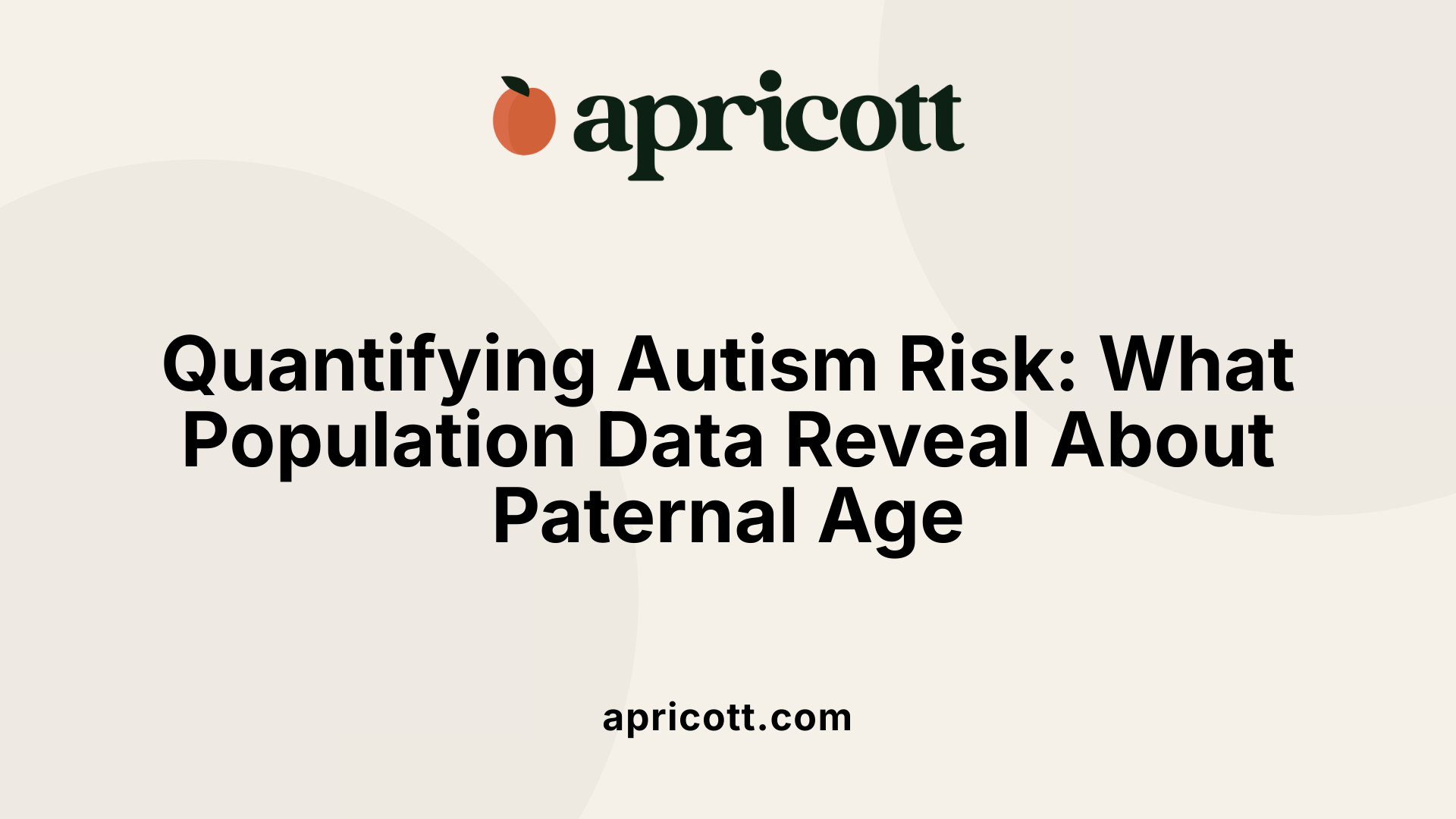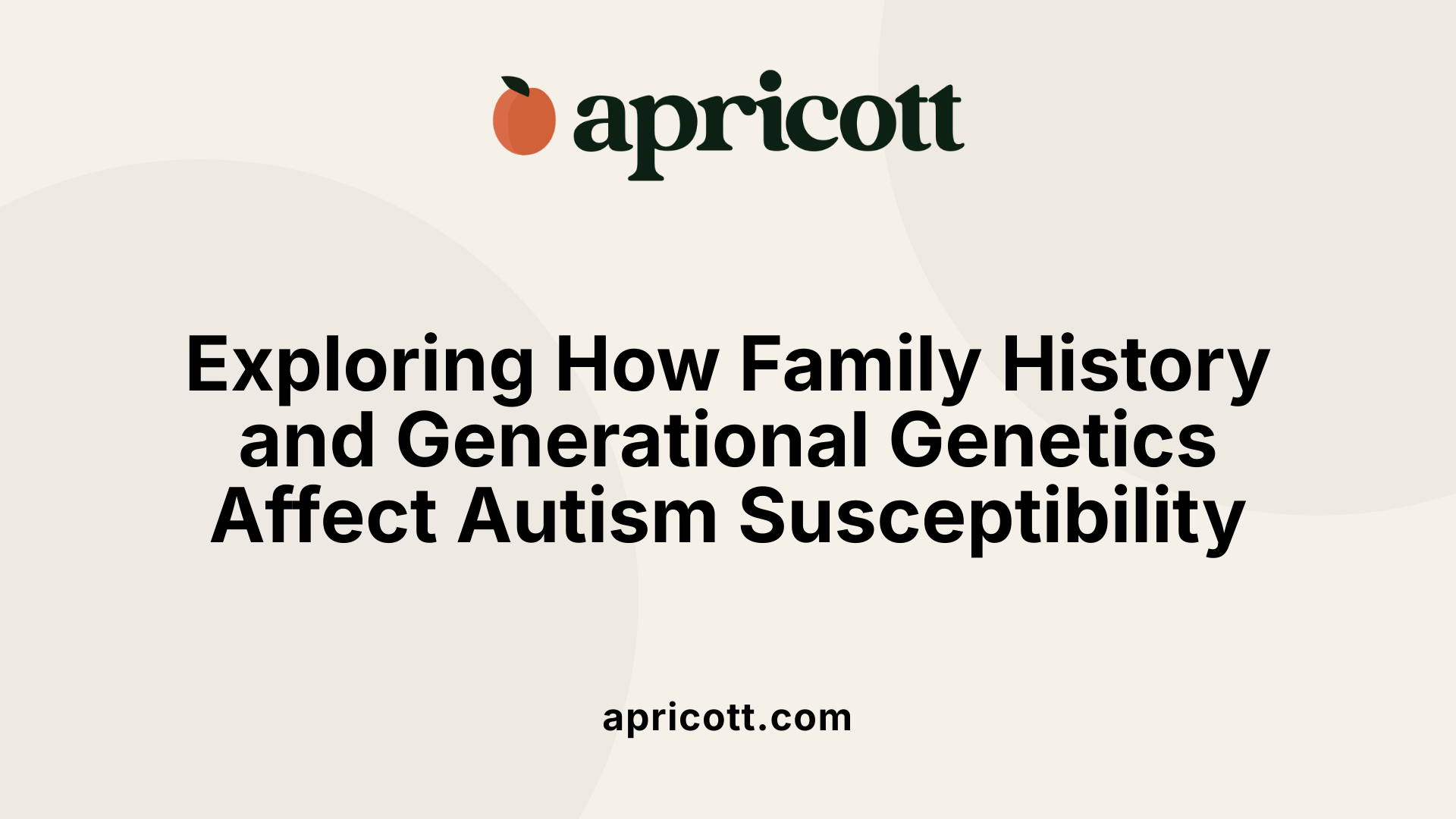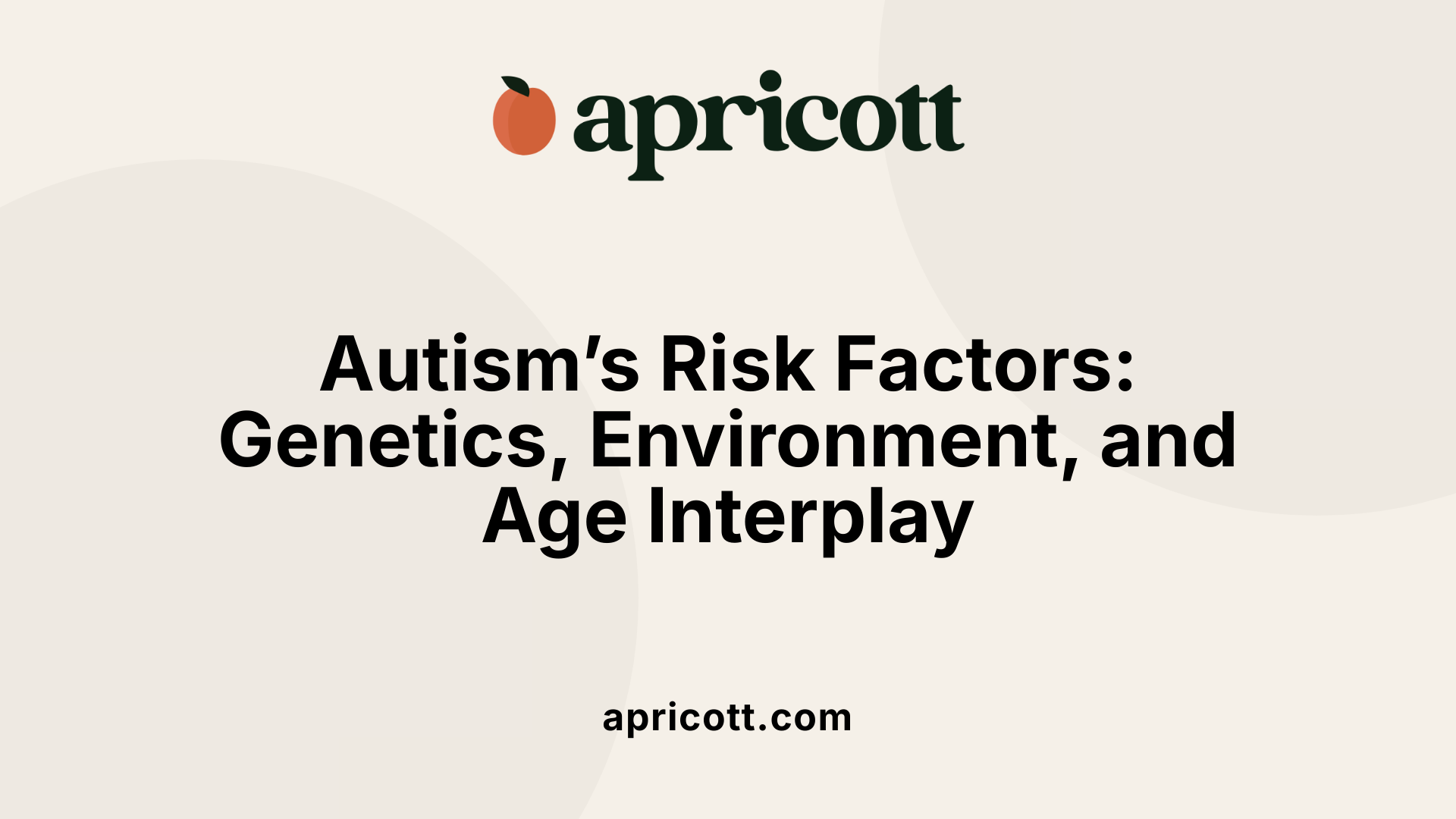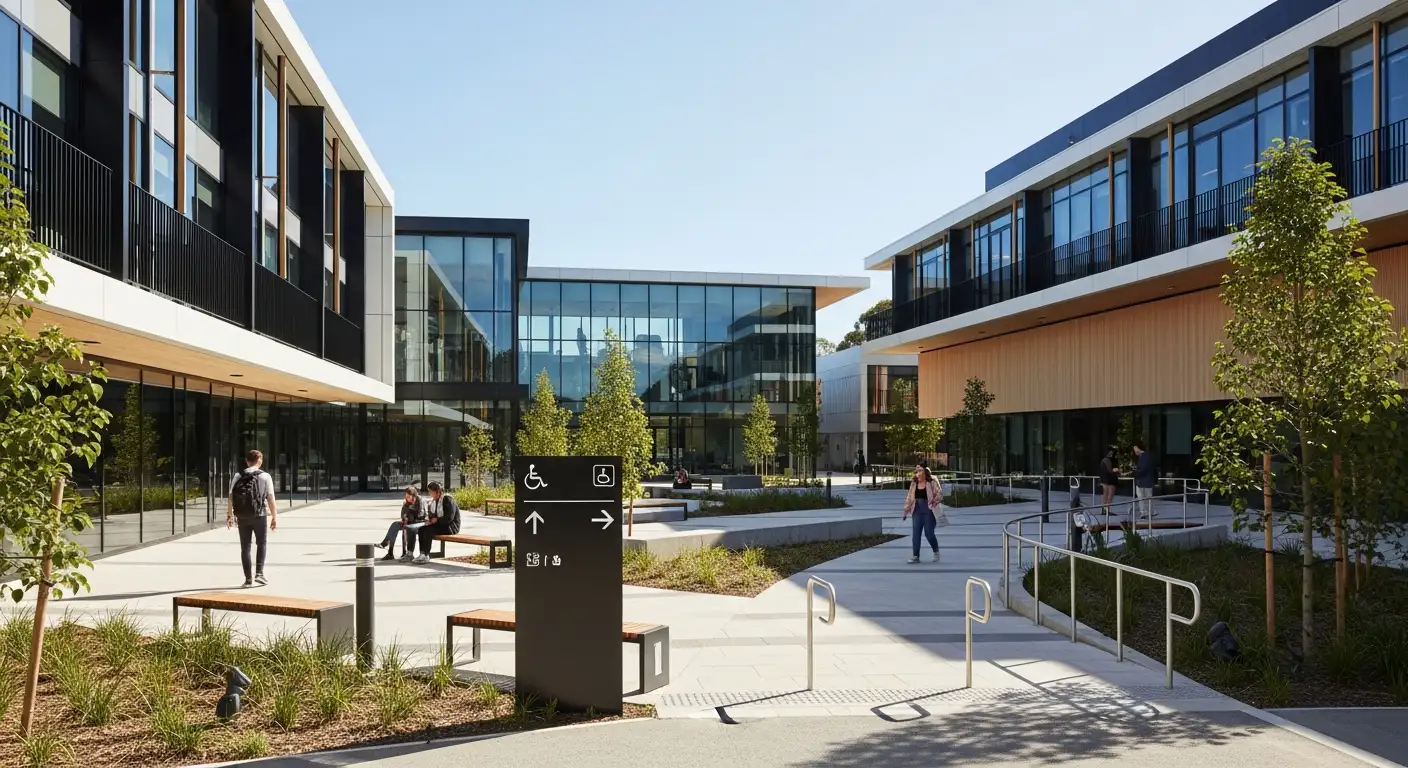Understanding the Scientific Evidence on Older Fathers and Autism
Recent research across multiple disciplines suggests that the age of fathers at the time of conception may be linked to an increased risk of autism spectrum disorder (ASD) in children. While the overall probability remains low, the correlation between paternal age and autism has garnered significant scientific interest, driven by biological, epidemiological, and genetic studies. This article delves into the nuances of this research, examining the evidence, potential mechanisms, and broader implications of older paternal age as a risk factor.
The Evidence from Population Studies and Risk Quantification

Do the risks of autism increase with paternal age?
Several studies over the past decade have found a clear link between paternal age and the likelihood of having a child with autism spectrum disorder (ASD). The evidence suggests that as men age, especially beyond 35 years, the risk for their children developing ASD increases.
Research indicates that children of fathers in their 40s and older are notably at higher risk. One study published in Molecular Psychiatry in 2011 found children of fathers in their 40s are 28% more likely, and those in their 50s are 66% more likely, to have autism compared to children of fathers younger than 30.
A comprehensive meta-analysis of 41 articles confirmed this trend. It reported that both maternal and paternal ages are associated with increased ASD risk, with odds ratios around 1.5. This means that with each increasing age group, the chance of having an autistic child rises steadily.
Interestingly, some research shows a different pattern for younger fathers. High-risk family studies have linked paternal age below 30 to increased ASD odds, possibly due to specific genetic or environmental factors not yet fully understood.
How much does risk increase with age?
Quantifying the risk, some studies have shown that the chance of developing autism increases by a range of approximately 5% to 400% based on paternal age. For example, fathers in their mid-40s may be about 5-10% more likely to have an autistic child than men in their 20s. Those over 55 are roughly four times more likely.
Despite these relative increases, the actual probability remains low in the general population. The baseline risk of autism in children of parents in their 20s is about 1.5%, rising to about 1.58% for those with fathers in their 40s.
Insights from international data and multigenerational effects
Large-scale datasets from countries like Sweden, Denmark, and California support these findings. A Swedish study involving almost 6,000 individuals with autism identified that the incidence of autism in grandchildren increased with the age of their grandfathers at the time of their birth.
Grandfathers aged 50 years or older had about a 1.7 to 1.8 times higher likelihood of having a grandchild with autism, depending on whether they had a son or daughter in that age group. This suggests that genetic and possibly epigenetic factors related to older paternal ages could accumulate over generations, further increasing risk.
In conclusion, the evidence from diverse population studies confirms that the risk of autism correlates with increasing paternal age, supported by statistical data showing both the magnitude and consistency of this relationship across different countries and datasets.
Biological Foundations: Mutations, Epigenetics, and Genomic Changes
What are the biological mechanisms that might link older paternal age to autism?
As fathers age, their sperm cells undergo biological changes that can influence the likelihood of having a child with autism. Two main processes are believed to be involved: the accumulation of genetic mutations and epigenetic modifications.
One of the most notable mechanisms is the increase in de novo genetic mutations in sperm. These are new mutations that are not inherited from the parents' own genetic material but occur spontaneously during sperm cell formation. Each time sperm cells divide, there is a small chance for errors in DNA copying. As men age, the number of cell divisions in spermatogonia (sperm precursor cells) increases, raising the chance of mutations. Studies estimate that these spontaneous mutations increase substantially with age, contributing to a higher risk of neurodevelopmental issues like autism.
A specific type of mutation known as point mutations—single-base changes in DNA—becomes more prevalent in older fathers' sperm. Structural variations such as insertions, deletions, or duplications of DNA segments may also occur. These irregularities can affect genes critical for brain development and functioning. The mutagenesis or 'copy error' hypothesis supports the idea that the biological process of DNA replication in spermatogenesis is less accurate with age, leading to genetic abnormalities that may increase autism risk.
In addition to genetic mutations, epigenetic changes—heritable modifications that do not alter the DNA sequence itself—also seem to play a role. DNA methylation, the addition of methyl groups to DNA, is a common epigenetic mechanism that influences gene expression. During spermatogenesis, precise DNA methylation patterns are essential for regulating genes involved in brain development.
As men age, these DNA methylation patterns can become dysregulated. Changes in methylation levels can disrupt the normal expression of imprinted genes—genes where typically only one allele (either maternal or paternal) is active while the other is silenced. Disruption in imprinting may lead to abnormal gene expression pathways relevant to neural development. Such epigenetic modifications have been linked to disorders including autism.
Some recent research highlights the interaction between genetic mutations and epigenetic alterations. For example, DNA methylation changes could mark some mutations or influence gene expression in a way that synergizes with DNA sequence mutations to elevate autism risk. Notably, some regions of differential methylation identified in the sperm of older fathers have also been found in brain tissues of individuals with autism, suggesting a biological connection.
Furthermore, the impact of older paternal age extends across generations. Studies indicate that grandchildren of older men have a heightened risk of autism, possibly due to inherited or cumulative effects of mutations and epigenetic modifications passed down through the paternal line.
In summary, advancing paternal age may influence autism risk through a combination of increased genetic mutations during sperm production and age-related epigenetic changes such as DNA methylation. These mechanisms can disrupt normal neural development and contribute to the etiology of autism, highlighting complex biological pathways that are still being actively researched.
Genetic Inheritance and Family Lineage Impact

Are older fathers more likely to have children with autism?
Research has consistently shown a correlation between increased paternal age and the likelihood of having a child with autism spectrum disorder (ASD). Studies spanning over a decade, including large-scale data from California, Denmark, Sweden, and an international dataset, reveal that the odds of autism rise steadily as the father ages.
Quantitative analyses demonstrate varying degrees of increased risk, from a modest 5% to as high as 400%. For example, fathers in their mid-40s are about 5 to 10% more likely to have an autistic child compared to those in their 20s. The risk becomes more pronounced after age 55, where men are approximately four times more likely to have a child with autism.
Biologically, this association is thought to stem from the accumulation of spontaneous genetic mutations in sperm as men age. These mutations, known as de novo mutations, are estimated to contribute around 20% to the increased autism risk linked to older paternal age. Despite the higher relative risks, the overall chance of having a child with autism remains relatively low—approximately 1.5% for children of fathers in their 20s and about 1.58% for those in their 40s.
Inheritance of mutations
The primary genetic explanation involves the accumulation of spontaneous mutations in sperm, which are passed to offspring. These mutations can affect gene sequences critical for neurological development, contributing to autism spectrum disorder. It's important to note that while these mutations increase risk, they do not guarantee the development of autism, as other factors also play roles.
Grandparental influence
Emerging research indicates that the influence of age extends beyond immediate parents. A comprehensive Swedish study examined generations of families and found that older grandfathers who had children at age 50 or older showed a higher likelihood of having grandchildren with autism—1.79 times for grandsons and 1.67 times for granddaughters. These findings suggest that the effects of older paternal age might accumulate across generations, possibly through multi-generational mutations or epigenetic changes.
Multigenerational effects
The possibility of multigenerational impacts is supported by evidence that some regions of DNA methylation changes in older fathers’ sperm are also found in the postmortem brain tissue of individuals with autism. This points toward epigenetic modifications—heritable changes that influence gene expression without altering the DNA sequence—playing a role in transmission of autism risk over generations.
Research indicates that the risks associated with paternal and grandpaternal age do not exist in isolation. Instead, they seem to compound over time, emphasizing the importance of considering family history and generational effects in understanding autism risk.
| Aspect | Findings | Additional Details |
|---|---|---|
| Increased risk with age | Fathers over 30, 40, and 55 show higher odds of having autistic children | Ranges from 5% to 400% increased risk, depending on age |
| Mutation inheritance | Accumulated spontaneous mutations in sperm pass to offspring | Estimated 20% contribution to autism risk |
| Grandparental influence | Older grandfathers associated with higher autism risk in grandchildren | Odds increase nearly 1.7 to 1.8 times at age 50 and above |
| Multigenerational effects | Epigenetic modifications from paternal sperm linked to autism traits in offspring | DNA methylation changes found in both sperm and brain tissue of autistic individuals |
Search for more information
When researching this topic further, using search terms like “older paternal age risk inheritance genetic mutations” can provide additional insights. This ongoing area of study continues to shed light on how family lineage contributes to autism risk across generations.
Epidemiological Evidence Across Countries and Populations

Do studies from different countries support the link between older paternal age and autism?
Research from various regions including Scandinavia, the USA, and international datasets consistently shows a connection between increased paternal age and autism risk in children. Large-scale cohort studies from Sweden, Denmark, California, and the broader international data, involving millions of children, reveal that children born to older fathers—often aged 40 and above—are significantly more likely to be diagnosed with autism spectrum disorder (ASD).
For instance, Swedish national register studies have identified over 5,900 children with autism and found that the risk of autism in grandchildren increases with the grandfather’s age at the time their parent was born. Specifically, grandfathers aged 50 or older had about 1.7 to 1.8 times higher likelihood of having a grandchild with autism compared to younger grandfathers.
Similarly, U.S. research and international meta-analyses reinforce this pattern, illustrating the worldwide relevance of the findings. These studies collectively underline that the relationship between paternal age and autism is not confined to one place but is a consistent trend observed across diverse populations.
How have large-scale studies contributed to understanding this association?
Large-scale cohort analyses, involving hundreds of thousands to millions of children, provide robust evidence supporting the link. For example, analyses from California and Scandinavia involved tracking children over several years, accounting for various confounding factors such as socioeconomic status, maternal health, and genetic background.
These investigations reveal a dose-response relationship: the older the father, the higher the child's risk of developing autism. For fathers in their 30s, the increased risk is about 1.6 times; for those in their 40s, the risk jumps to approximately six times compared to fathers younger than 30. Over age 55, the likelihood of having an autistic child can be about four times higher.
Are these findings consistent and reliable?
Yes, the consistency across multiple studies supports a reliable association. Meta-analyses compiling data from numerous articles confirm that both maternal and paternal ages independently contribute to autism risk, with odds ratios around 1.5 to 1.6 for older parents.
Moreover, the relationship exhibits a dose-response pattern, with risk increasing gradually with paternal age. This consistency indicates that older paternal age is a genuine risk factor, though it accounts for a relatively small percentage of overall autism cases.
What biological mechanisms are proposed to explain this?
The primary biological explanation involves the accumulation of genetic mutations in sperm as men age. Older sperm cells tend to acquire more de novo mutations, which can disrupt normal brain development in the offspring.
Additionally, age-related changes in sperm DNA methylation—a form of epigenetic modification—may influence gene expression related to autism. Changes in the epigenetic landscape of sperm could pass to the child and increase autism susceptibility.
In summary, extensive epidemiological evidence from multiple countries supports the conclusion that advancing paternal age, especially in the 40s and beyond, correlates with a higher risk of autism in children. The repeated observations across diverse populations strengthen the understanding that age-related genetic and epigenetic changes in sperm are meaningful contributors to this increased risk.
| Study Region | Sample Size | Main Findings | Risk Increase | Referenced Figures |
|---|---|---|---|---|
| Scandinavia | 5,936 with autism + controls | Older paternal/grandfather age correlates with higher autism risk | 1.7–1.8 times higher risk for grandfathers ≥50 | Johnson Hopkins, Swedish registry |
| USA | Large cohorts | Consistent correlation; dose-response relationship | Fathers ≥40 face 6 times the risk | California studies |
| International | Meta-analysis of 41 articles | Maternal and paternal ages both contribute | OR around 1.51-1.58 | Multiple population studies |
These converging pieces of evidence affirm that older paternal age is an important factor to consider when studying autism risk across populations.
The Role of Epigenetics and DNA Methylation

What does research say about the connection between paternal age and autism?
Research consistently shows a significant link between older fathers and a higher chance of autism in their children. Studies reveal that children of men aged 40 or above are up to 5.75 times more likely to be diagnosed with autism compared to children of younger fathers.
Meta-analyses, which combine results from more than 40 observational studies, show that higher paternal age increases autism risk by about 1.51 times. Interestingly, the influence of maternal age appears less significant once other factors are considered.
The biological reasoning behind this connection points to mechanisms like de novo genetic mutations—new mutations that arise spontaneously—as well as epigenetic modifications and changes in genetic imprinting, all of which tend to accumulate in sperm as men age.
Large-scale population studies from places such as Israel, California, and Scandinavia reinforce this pattern. They show a steady increase in autism risk with paternal age, especially after age 40.
While paternal age contributes to some of the rising autism cases globally, it is only one part of a complex puzzle involving multiple genetic, environmental, and lifestyle factors.
DNA methylation changes with age
DNA methylation is an epigenetic process that involves adding methyl groups to DNA, often influencing how genes are turned on or off. Recent research finds that as men age, significant changes occur in the DNA methylation patterns within sperm.
These modifications can alter the expression of genes, including those involved in brain development and function.
Studies identify around 94 regions in sperm DNA where methylation levels differ markedly in older men. These areas are associated with genes linked to autism and social behavior.
The methylation differences observed range from about 5.5% to 8%, which are substantial enough to influence gene activity.
Impact on gene expression
Changes in DNA methylation can activate or suppress specific genes. In sperm, these modifications can be passed to the embryo, potentially affecting neurodevelopment.
Research shows that some regions of differential sperm methylation are also present in the postmortem brains of individuals with autism. This suggests that epigenetic changes in sperm may influence gene expression in ways that increase autism risk.
For example, genes involved in neural connectivity, synapse formation, and social recognition are sensitive to methylation patterns. When these patterns are altered due to aging, they may impact the child's brain development.
Link to autism traits
A recent study by Johns Hopkins University focused on the epigenetic marks on paternal sperm. The research found that specific methylation changes correlated with higher scores on the social responsiveness scale (SRS), a measure of autistic traits.
Participants, aged 28 to 51, showed that certain methylation differences—ranging from 5.5% to 8%—were associated with more pronounced autistic traits in their children.
Some of these methylation patterns were also detected in brain tissue of individuals with autism, suggesting a biological connection.
These findings support the idea that epigenetic modifications, influenced by paternal age, can contribute to autism traits in offspring.
| Aspect | Details | Additional Notes |
|---|---|---|
| DNA Methylation Changes | Significant differences in sperm DNA methylation with age | 94 regions identified; methylation varies by 5.5% to 8% |
| Impact on Genes | Altered methylation in genes involved in brain development | Affects neural connectivity, social behavior |
| Autism Traits Link | Methylation patterns associated with autism-related scores | Patterns also found in autism brain tissue |
Understanding how aging impacts sperm DNA methylation helps illuminate one pathway through which paternal age may influence autism risk. These epigenetic changes, combined with genetic mutations, form a complex picture of how later parenthood might contribute to the increasing prevalence of autism in current populations.
Inheritance Across Generations and Grandparental Influence
How do genetic data from grandparents and grandchildren reveal inheritance patterns?
Research focusing on long-term genetic inheritance includes analysis of data from grandparents and grandchildren to understand how autism risk may be transmitted across generations. Studies utilizing national registers, such as those from Sweden, have tracked thousands of individuals to identify patterns linked to grandparents’ ages at the time their children or grandchildren are born.
By examining these extensive datasets, researchers can observe correlations between grandparental age and autism prevalence. Genetic data from these sources often show that mutations or epigenetic changes accumulate with increasing age, which may be passed down through family lines. Such studies aim to determine whether these genetic or epigenetic factors contribute cumulatively to autism risk.
What is the impact of grandfathers' ages on autism risk?
Grandfather age, particularly when he is 50 years or older at the time his child was born, appears to influence autism risk in grandchildren. Studies have demonstrated that grandfathers in this age group are associated with a higher likelihood of having grandchildren diagnosed with autism.
Specifically, research indicates that grandfathers aged 50 or older had a 1.79 times higher chance of their granddaughter having autism if they had a daughter at that age. For grandsons, the increased risk was slightly lower but still significant at approximately 1.67 times.
This pattern suggests that age-related genetic mutations or epigenetic modifications in paternal lines could be transmitted across multiple generations, impacting the development of autism in descendants.
How does risk accumulate over generations?
Evidence increasingly supports the idea that the risk factors for autism are not limited to a single generation but can build up over time. The notion of cumulative risk involves the gradual increase in genetic mutations, such as de novo mutations and alterations in DNA methylation, which occur more frequently as men age.
Genetic and epigenetic alterations—like changes in sperm DNA methylation patterns—can influence gene expression related to neurodevelopment. When these modifications are passed down, they may enhance susceptibility to autism in offspring.
Recent studies suggest that, over successive generations, these accumulated mutations and modifications could contribute to an overall increase in autism prevalence. Such findings emphasize the importance of understanding familial and generational genetic changes as part of the broader picture of autism etiology.
| Aspect | Findings | Details |
|---|---|---|
| Grandparental impact | Older grandfathers linked with higher autism risk | Grandfathers aged 50+ have 1.79 (daughters) and 1.67 (sons) times higher chance of grandchildren with autism |
| Risk accumulation | Variations build over generations | Genetic mutations and epigenetic changes increase with age, passed through lineages |
| Genetic and epigenetic factors | Transmission influences susceptibility | Mutations and DNA methylation alterations in sperm may impact brain development |
| Broader implications | Combined effects over time | The lessening of risk over generations suggests a cumulative effect, emphasizing multigenerational inheritance patterns |
These studies underscore that autism risk factors associated with parental age are likely to have multigenerational implications, with older paternal and grandpaternal ages contributing to increased susceptibility in descendants.
Complex Factors and the Multifactorial Nature of Autism Risk

What does the overall research conclude about older paternal age and autism?
Extensive research indicates that having an older father increases the likelihood of autism spectrum disorder (ASD) in children. Studies from various countries, including large-scale analyses from California, Denmark, and Sweden, consistently show a steady rise in autism risk with increasing paternal age. For example, fathers in their 30s are about 1.6 times more likely, and those in their 50s are roughly six times more likely, to have a child with autism compared to fathers under 30.
Biological mechanisms such as the accumulation of spontaneous genetic mutations—known as de novo mutations—in sperm explain part of this increased risk. These mutations appear more frequently as men age, accounting for approximately 20% of the elevated risk. Additionally, epigenetic changes like DNA methylation alterations have been linked to paternal age and autistic traits, suggesting that modifications in gene regulation, rather than just gene sequence, also play a role.
However, these biological factors do not fully account for the rising autism prevalence. Environmental influences, socioeconomic factors, and other parental health-related components also contribute to the overall risk. For example, maternal age patterns, while influential, present a more complex picture, with some studies indicating a risk increase with very young or older mothers. The influence of multiple influences, including genetic inheritance, lifestyle, and environment, paints a picture of autism as a condition with multifaceted origins.
Statistically, while higher parental age increases risk, the absolute chance remains low, around 1-2%. A large meta-analysis encompassing 41 studies found that both maternal and paternal ages are associated with significant increases in autism risk, with odds ratios of about 1.5 to 1.6.
Furthermore, evidence extends beyond individual parents: recent research suggests that the age of grandparents, especially grandfathers, also impacts autism likelihood in grandchildren. Older grandfathers, particularly those over 50, are associated with a higher probability of grandchildren with autism, hinting at genetic and epigenetic changes passing across generations.
In summary, the relationship between paternal age and autism is supported by numerous studies, but it remains one component among many in the complex web of contributing factors. The interplay of genetics, epigenetics, environment, and inherited traits underscores the multifactorial etiology of autism.
Factors Influencing Autism Risk
| Factor | Influence | Description |
|---|---|---|
| Paternal age | Increased risk | Older fathers have higher chances of having autistic children, increases from 5% to 400% depending on age |
| De novo mutations | Genetic mutations | Spontaneous mutations in sperm accumulate with age, contributing significantly to risk |
| Epigenetic modifications | DNA methylation changes | Alterations in gene regulation linked to older age and autism traits |
| Maternal age | Variable influence | Some evidence suggests increased risk with very young or very old mothers |
| Genetic inheritance | Family traits and genetics | Family history and inherited genetic factors play a role |
| Environmental factors | Lifestyle and exposures | External environmental influences can modify risk |
| Multigenerational effects | Passing of risk factors | Older grandparents’ age correlates with increased autism risk in grandchildren |
Limitations and Ongoing Debates
While the evidence clearly links older paternal age to autism risk, scientists acknowledge that this relationship is part of a complex puzzle. Variables such as lifestyle choices, environmental exposures, socioeconomic status, and specific genetic backgrounds also contribute. Current studies face limitations, including difficulty isolating individual factors and accounting for diverse populations.
Some researchers emphasize the need for more detailed research into epigenetic mechanisms and gene-environment interactions. Additionally, because autism is inherently multifactorial, no single factor like paternal age can fully explain its prevalence.
The general consensus remains that advanced paternal age is a notable risk factor but not an independent determinant. It interacts with other genetic and environmental influences, making autism a multifaceted condition that requires comprehensive understanding. Ongoing research aims to clarify these interactions and improve risk assessment, ultimately guiding better preventive strategies and counseling.
Understanding the Broader Context of Paternal Age and Autism
While the association between older paternal age and increased autism risk is supported by a growing body of scientific evidence, it is important to recognize that this is one piece of a complex puzzle. The biological mechanisms, including mutation accumulation and epigenetic alterations, provide plausible explanations, yet they do not fully account for all cases. Environmental and genetic factors, alongside socioeconomic and health-related influences, also play critical roles in autism’s multifactorial etiology. Crucially, even among older fathers, the absolute risk remains low, highlighting the importance of considering paternal age within a broader context of risk factors and individual characteristics. Ongoing research aims to refine our understanding and guide potential interventions, but it is clear that paternal age is a significant, yet partial, piece of the autism risk landscape.
References
- Does Older Sperm Cause Autism?
- The link between parental age and autism, explained
- Changes in Father's Sperm Linked to Autistic Traits in Their ...
- A assessment of the effects of parental age ... - BMC Psychology
- Older grandfathers pass on autism risk through generations
- The link between parental age and autism, explained
- A assessment of the effects of parental age ... - BMC Psychology
- Does Older Sperm Cause Autism?
- Child's Autism Risk Accelerates with Mother's Age Over 30
- A assessment of the effects of parental age ... - BMC Psychology
.svg)
.svg)








